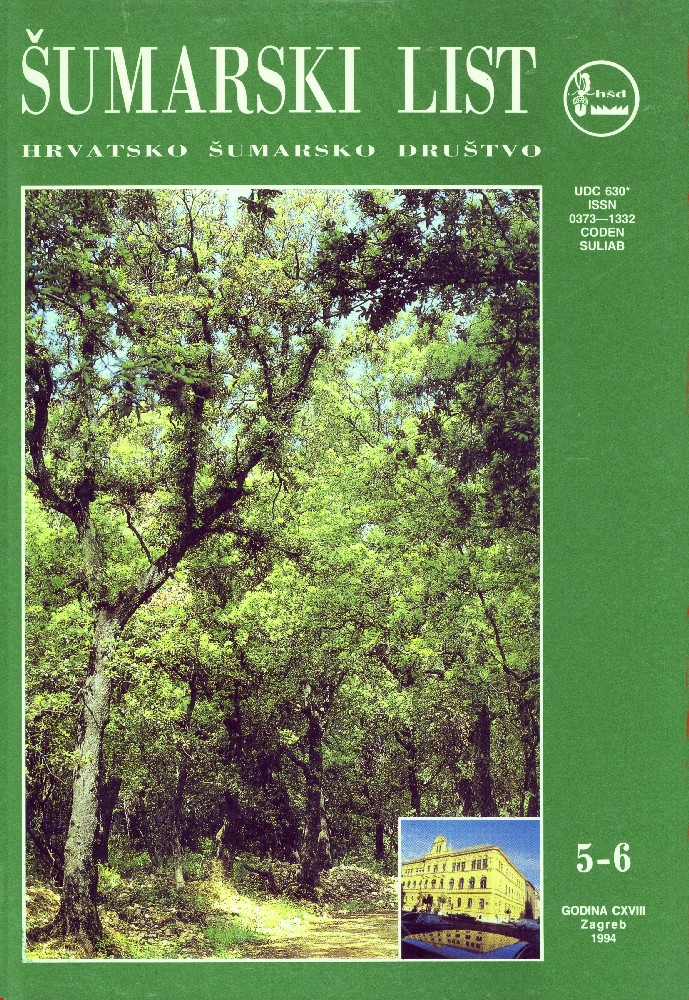| |
| IZVORNI ZNANSTVENI ČLANCI |
| |
|
|
| Orlić, S., Ocvirek, M. | UDK 630* 232.001/2 (Pseudotsuga menziesii (Mirb.) Franco) |
| Research in Provenanses of Douglas Fir (Pseudotsuga menziesii (Mirb.) Franco) in Croatia
pdf
HR
EN
|
139 |
| Komlenović, N., Krstinić, A. | UDK 630* 161.6 (Populus sec. Aigeiros and Tacamahaca) |
| Some physiological Characteristic of Croatia Polar Clons of Sections Aigeiros and Tacamahaca
pdf
HR
EN
|
147 |
| Španjol, Ž. i Wolf, S. | UDK 630* + 712 |
| Biological-Environmental and Space Valorization Park-Forest »Komrčar« on the Island of Rab
pdf
HR
EN
|
153 |
| Huber, D., Radišić, B., Novosel, D., Frković, A. | UDK 591.5 (497.13) (Canis lupus) |
| Survey of Public Atitude Twords Wolves in Croatia
pdf
HR
EN
|
167 |
Summary: The attitude of people towards wolves in Croatia was studied by taking a total of 106 questionnaires: 53 by people that cohabitate with wolves in Gorski kotar (»rural«) and 53 from urban areas of towns Karlovac and Zagreb (»urban«). Each quiz, containing 12 groups of questions, was completed by interview. The results were compared with former surveys from 1983 (Gyorgy 1984) and 1986187 (Huber et al. 1992). A very positive change of general attitude towards wolves in Croatia compared to the last 6 or 10 years before was documented. The overall percentage of people considering the wolf as a harmful species dropped from 42 in 1983 to 25 in 1993 (Chi2 = 10.2). However, already in 1985 only 9 of foreign visitors to Croatia considered the wolf as a harmful species: In 1983 even 21 people wanted to exterminate wolf, compared to 8 today (Chi2 = 9.19), while only 5 of foreign visitors to Croatian in 1985 had the same opinion. The percent of rural people that would like to introduce again the bounties for killed wolves dropped significantly from 1986/87: from 85 to 23, Chi2 = 38.86, as well as the ones that would again like to use poisons against wolves: from 26 to 4, Chi2 = 8.91. Ninety percent of all examinees agree that the wolf population decreased in the last 20 years in Croatia. It can be concluded that the size of wolf population, and the related size of damage are the principle determinants of attitude of local human population towards wolves. From 1986187 the wolf dropped from the fourth to the seventh place as a pest animal in the people´s minds. The attitude towards wolves in Croatia seems already favorable enough for the urgent introduction of legal protection. Additional informing and educating the public about the real wolf population status would further contribute to the conservation of species. Saving the wolves in Croatia would help save their population in the neighboring Slovenia, and it is an essential step to facilitate further dispersal of wolves towards northwest, i.e. Alps.Summary: The attitude of people towards wolves in Croatia was studied by taking a total of 106 questionnaires: 53 by people that cohabitate with wolves in Gorski kotar (»rural«) and 53 from urban areas of towns Karlovac and Zagreb (»urban«). Each quiz, containing 12 groups of questions, was completed by interview. The results were compared with former surveys from 1983 (Gyorgy 1984) and 1986187 (Huber et al. 1992). A very positive change of general attitude towards wolves in Croatia compared to the last 6 or 10 years before was documented. The overall percentage of people considering the wolf as a harmful species dropped from 42 in 1983 to 25 in 1993 (Chi2 = 10.2). However, already in 1985 only 9 of foreign visitors to Croatia considered the wolf as a harmful species: In 1983 even 21 people wanted to exterminate wolf, compared to 8 today (Chi2 = 9.19), while only 5 of foreign visitors to Croatian in 1985 had the same opinion. The percent of rural people that would like to introduce again the bounties for killed wolves dropped significantly from 1986/87: from 85 to 23, Chi2 = 38.86, as well as the ones that would again like to use poisons against wolves: from 26 to 4, Chi2 = 8.91. Ninety percent of all examinees agree that the wolf population decreased in the last 20 years in Croatia. It can be concluded that the size of wolf population, and the related size of damage are the principle determinants of attitude of local human population towards wolves. From 1986187 the wolf dropped from the fourth to the seventh place as a pest animal in the people´s minds. The attitude towards wolves in Croatia seems already favorable enough for the urgent introduction of legal protection. Additional informing and educating the public about the real wolf population status would further contribute to the conservation of species. Saving the wolves in Croatia would help save their population in the neighboring Slovenia, and it is an essential step to facilitate further dispersal of wolves towards northwest, i.e. Alps.
|
| |
| STRUČNI ČLANCI |
| |
|
|
| Tomašević, A. | UDK 630* 232.216 |
| Undermining as First Stage of Soil Preparation for Afforestation
pdf
HR
EN
|
173 |



